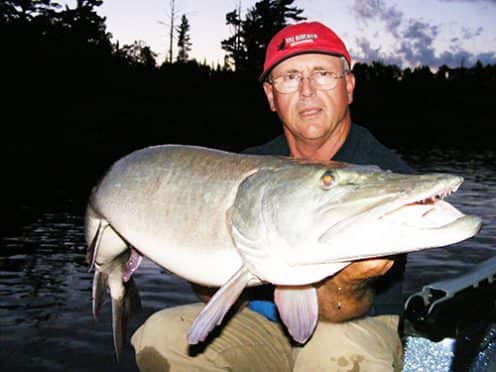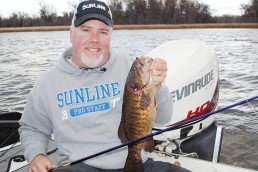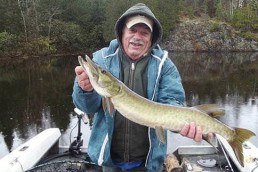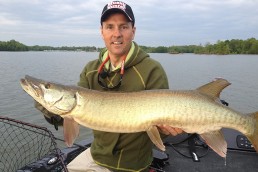You’ll Catch Muskies When They’re Biting
SHARE THIS POST
I fully admit that muskies are not nearly as easy to catch as it might appear on my TV show segments. I definitely have plenty of bad days and get frustrated by entire trips that are tough.
A few days without catching a muskie, and I’m as grouchy as the next guy. But eventually I come to grips with what’s in front of me and develop a very stubborn never-give-in attitude. This has served me well and usually turns the tables in my favor.
In other words, attitude comes into play when muskies get lockjaw.

Muskies are sure to be tighter to cover and more reluctant to move any distance to strike when conditions go sour. High-speed, run-n-gun baits, such as inline spinners and many topwater lures, might not trigger strikes now. Instead, lures worked right next to cover in a jerk-rise fashion are apt to trigger a better response.
A personal favorite for these conditions is a floating/diving slab-sided minnow such as a straight model ShallowRaider. I will purposely jerk these slab baits with a lot of slack line when they are near cover, accentuating the lateral side-to-side action and hang time. This not only triggers strikes, but also reveals the presence of a muskie because one is likely to rise up out of the cover to at least inspect the bait. Essentially, this trick triggers a vertical follow instead of a horizontal one. I’ve used this tactic a lot to locate a good fish that I might revisit later in the same day.
Are you enjoying this post?
You can be among the first to get the latest info on where to go, what to use and how to use it!
It is always important to watch for a pattern of any kind to develop. Sometimes the key is being out in the wind casting over shallow rocks or to wave-smashed points. But warm, sun-baked bays with good weed growth might also hold the key to success. Don’t be surprised if a single downed tree located along a steep, shaded bank gives up your only fish of the day. Keep watching for any pattern of positive movement in one given type of terrain and condition over another and check other areas with similar surroundings. With any luck, you will establish a pattern of some sort. When things are truly tough, catching a couple of muskies in one day off similar spots is indeed a pattern.
Boat control is one more thing to take seriously as conditions toughen up. Instead of drifting, approach the target area from a downwind perspective and work against the waves. The goal here is total control of your boat speed over a spot. This is especially important on small areas with a specific piece of cover such as a downed tree or a small patch of weeds. Point your boat bow directly into the wind, make short, precise casts to a potential piece of cover and work it slowly and thoroughly. Your boat is less likely to wander too close to cover and spook the fish when worked in this manner.
Another technique that has been exceptionally good for me in a tough muskie bite is something I have termed “the bump and grind.” Essentially, it involves working a smaller, 6- to 7-inch deep diver, such as a DepthRaider, over cover and terrain otherwise better suited for bucktails, topwater lures and shallow minnow baits. Instead of launching long casts over such spots and fast-crankin’ a high-riding bait such as an inline spinner, the tactic involves shorter pitches combined with constant cover collision. Literally, I am suggesting you run the lure into everything in a bump and grind fashion. As soon as the bait collides with anything, stop and allow it to rise up a count or two. Then resume the retrieve for a short distance until it collides again. It might feel completely unorthodox at first, but with a little practice you will eventually find a rhythm allowing you to manipulate a deep diver through almost any type of terrain.
Muskies are more apt to hold a tad deeper on any given piece of cover or structure during adverse conditions, so doing the bump and grind with a small deep diver is likely to place the bait closer to the fish as well as working it over terrain that is simply too deep for traditional shallow-running lures. It’s important to remember that working a lure only a few feet deeper might make all the difference under these conditions. Couple that with a smaller offering, and you’re sure to trigger at least one strike on an otherwise fishless day.
Finally, I’ve had similar positive results doing the bump and grind with a jointed ShallowRaider over high-cresting rock reefs during real windy, bluebird, post-frontal conditions in Canadian waters. In fact, I now purposely seek out boating hazard reefs during a tough bite just so I can bump and grind them a few times with my old trusty jointed SR. Rarely does a year go by that I don’t put a couple of my best muskies in the boat with this little trick. Boat control is always a challenge in big waves near hazardous rocks. Even after you hook a fish, you have to be careful so you don’t end up crashing into the rocks. But the chance for success more than outweighs the risk.
MWO
SHARE THIS POST
Did you enjoy this post?
You can be among the first to get the latest info on where to go, what to use and how to use it!
Joe Bucher
Joe Bucher is a Freshwater Fishing Hall of Fame Legendary Angler, book author, lure designer and host of Fishing with Joe Bucher TV series.



